Important note: Before buying this or ANY mag-sealed reel, please read this.
--------------------------------------------------------------------------------------------------------------------------------------------------------------------
Saltiga Expedition 2014 : The Saltiga
Expedition?
Only 4 years after the release of the second generation Saltiga in 2010, Daiwa has released the 2014 Saltiga Expedition. The name "Expedition" first came to life in April 2004 as one of the spin-offs of the original 2001 Saltiga Z spinning reel. That first Expedition was basically a Saltiga Z of the 6XXX size class in a blue colour scheme, it came with a higher capacity spool, a ball metal handle grip, no seals in the line roller for lighter rotation, and most notably it was a specialised jigging reel with its 4.3:1 gear ratio. The other spin-offs of the original Saltiga Z were the Dogfight; a high speed popping version in a black colour scheme, and later on the red "S-Extreme" and red/black "S-Extreme Maverick". These two "S-Extreme" reels had upgraded drag washers to address the stickiness issue of the standard Saltiga Z, and were sold exclusively in Australia. The new 2014 Expedition though is a completely different story. Rather than being a spin-off of the 2010 Saltiga, the reel has changed dramatically enough for me to consider it a new generation without thinking twice. Daiwa wouldn't explicitly say that it's a new generation, probably not to render their 2010 Saltiga obsolete, but the radical redesign of the Expedition makes it so regardless of what they say.
In addition to that, looking at Daiwa's Japanese site we see this
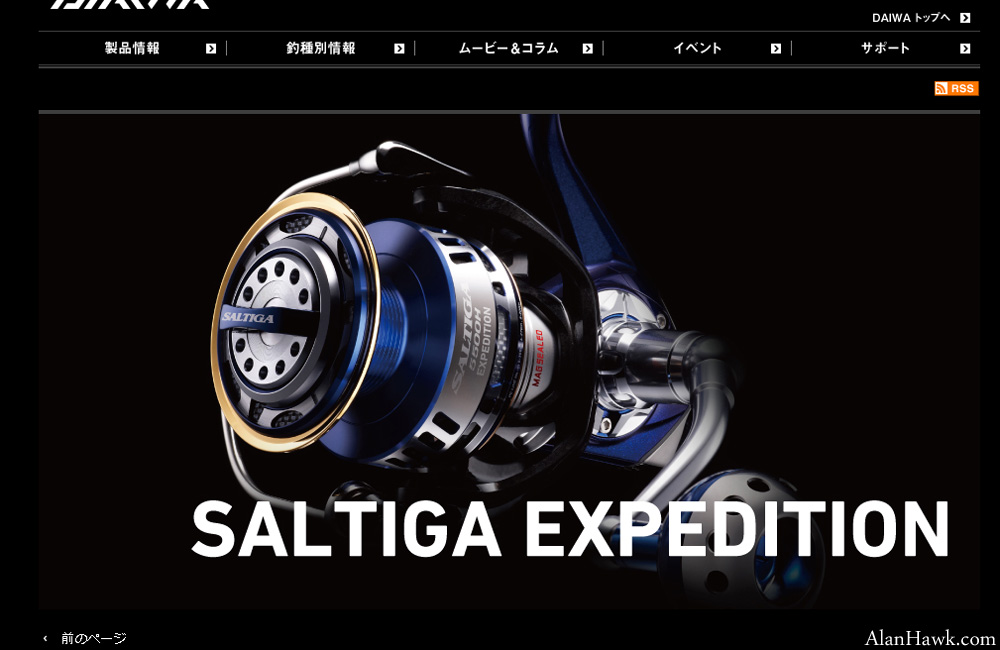 The Expedition has its own separate page.
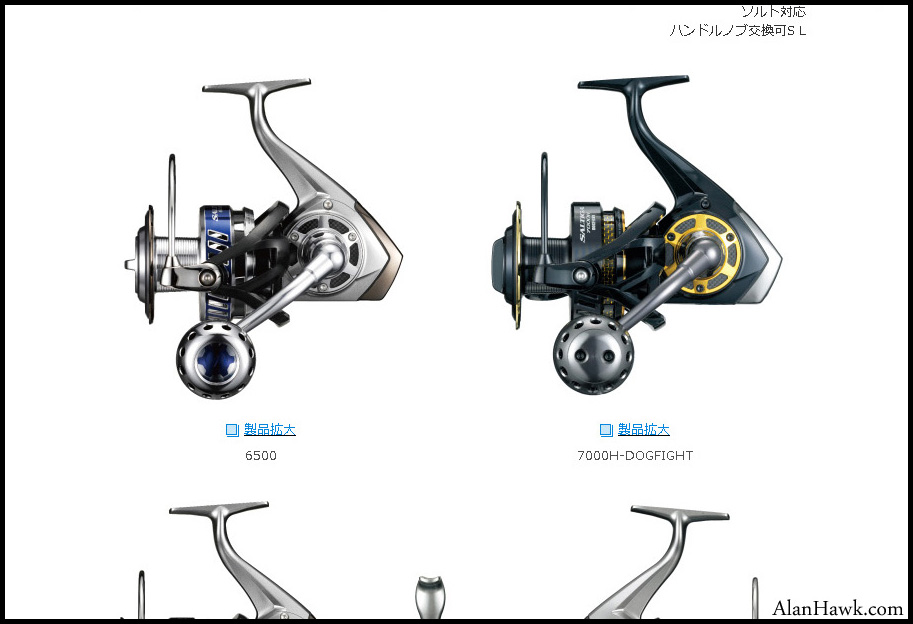 The Dogfight on the other hand appears on the same page as the 2010 Saltiga since it's a regular spin-off.
Unboxing the new reel
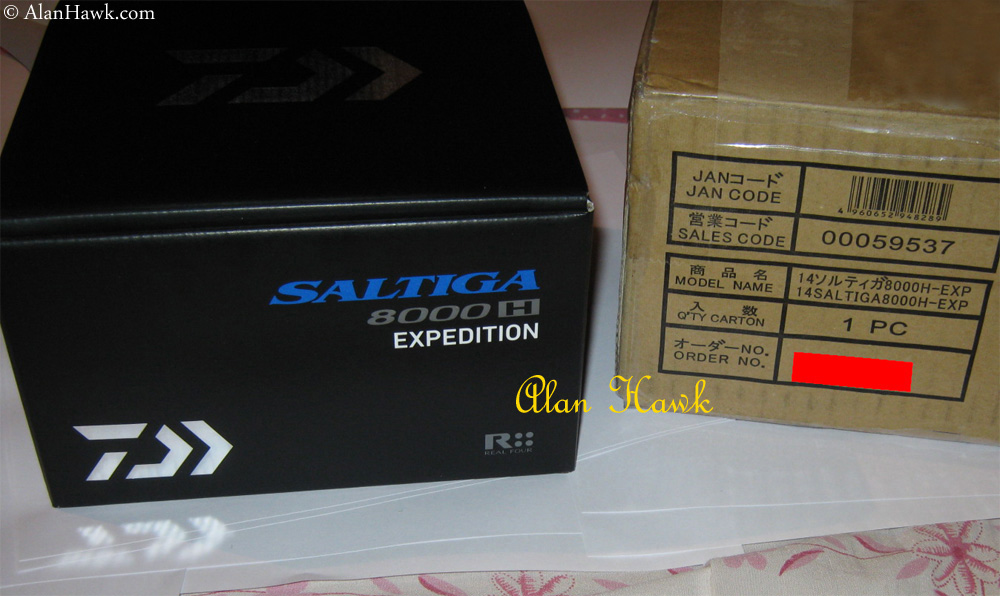 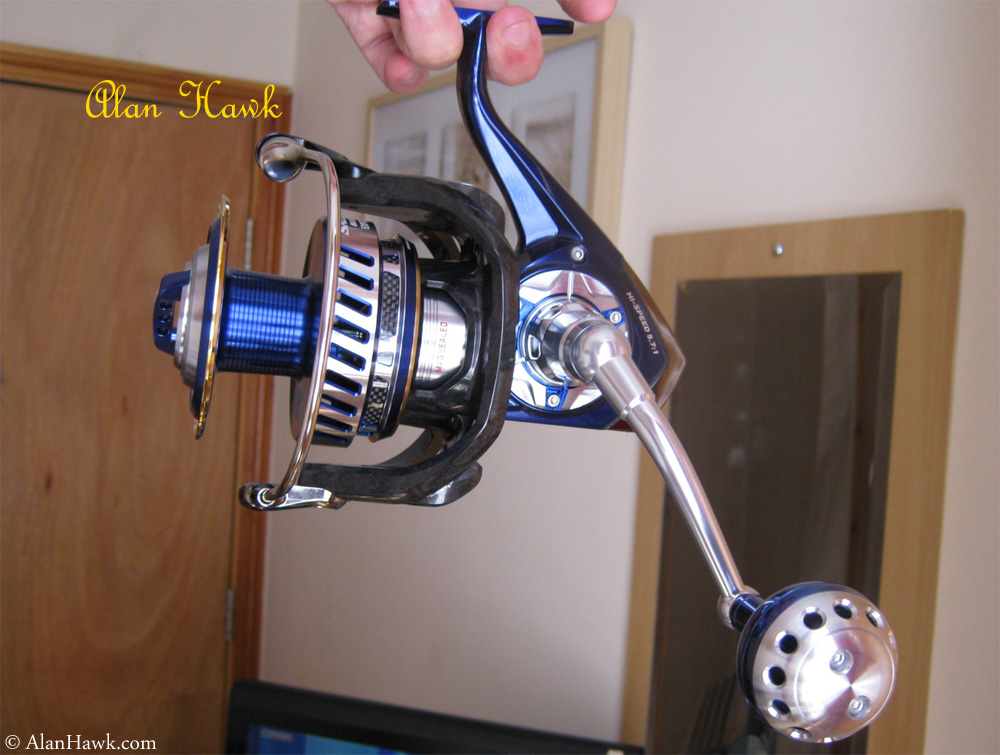 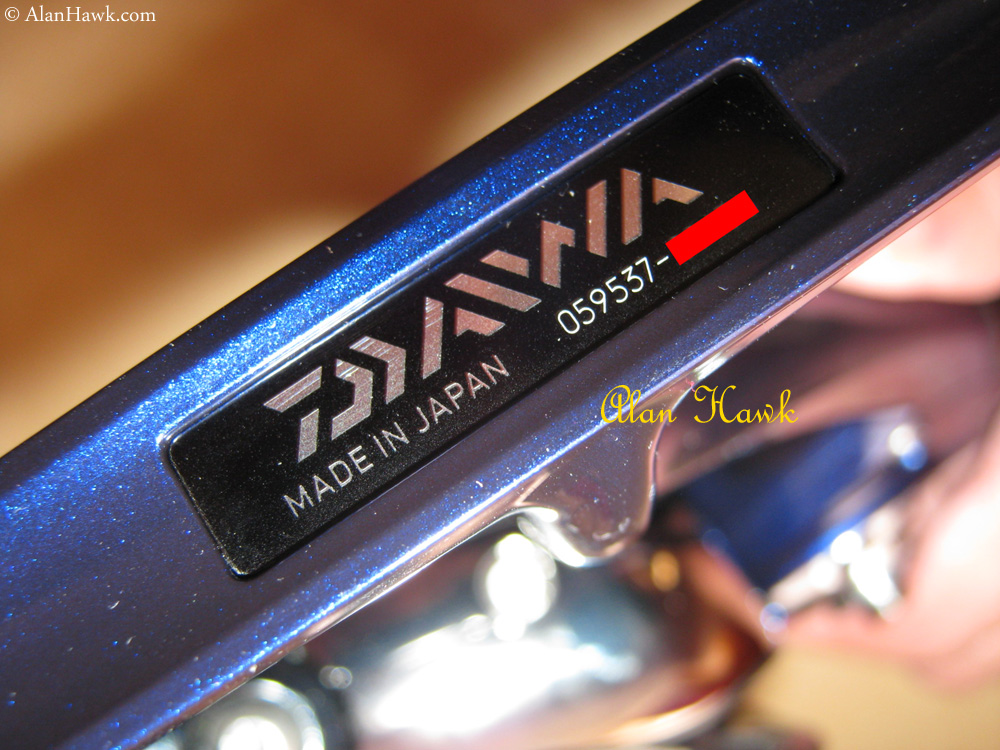 I usually say a couple of words about a reel's appearance before I move on to practical stuff, but this time I'll say more than a couple of words because the looks of this thing is literally breathtaking! When I reviewed the 2010 Saltiga I said that it's one of the most beautiful reels in the world, still the body/rotor colour combination wasn't exactly perfect, and the carbon inserts in the frame were too futuristic for my conservative taste. The visual design of new Expedition though is just the right formula; body is royal blue with silver accents, the new drag knob is pure class, the two-tone star shaped body engine is decisively characteristic, and the carbon inserts are gone from the frame and are now limited to the spool where they belong.
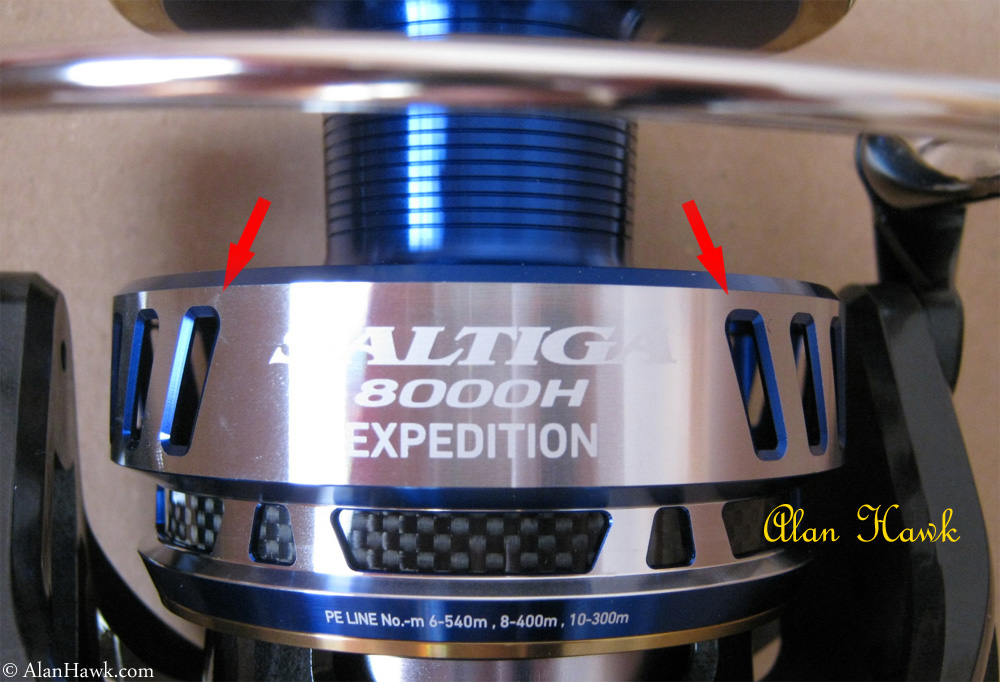 The cuts in the skirt of the spool tilt in opposing directions, which looks really good and creates a nice effect when the spool spins.
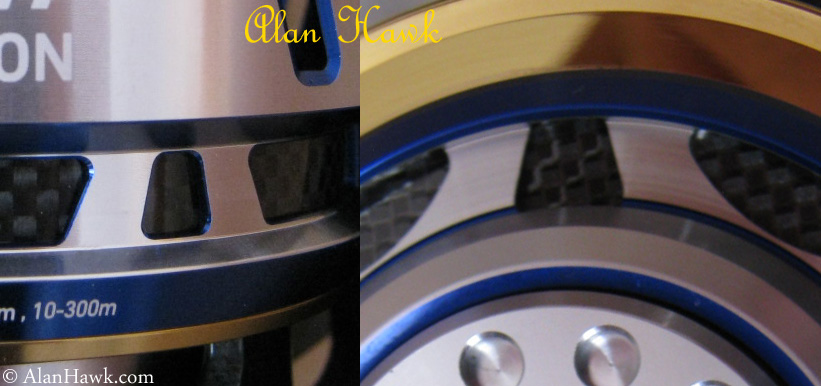 The posts in the skirt are made to match the posts in the spool cap. Obviously an actual artistic design specialist took the time to put these aesthetic touches, and the result is nothing short of brilliance.
To summarise, people usually refer to good looking fishing gear as "tackle porn", but to me the Expedition is not just regular porn. The right analogy for this reel would be a leaked sex tape of Scarlett Johansson with Monica Bellucci.... Well, I've just looked at the reel on my desk and I'd like to add to that scenario Maria Sharapova and Melanie Laurent walking on Scarlett and Monica, and after the initial shock and a short argument they decide to join in!!
 Description of the Saltiga
Holding the new Expedition gives you that instant feeling of extreme solidity that no other reel gives except maybe a big surf Van Staal. Nothing shakes, nothing feels or sounds hollow, and it has that trademark near-zero handle play that has been a distinct feature in all Saltigas since the beginning. I will talk about that phenomenon later on. The Expedition 8000H is a high speed reel and at 5.7:1 ratio it's a tool for topwater fishing with poppers and stick baits. It holds 550 metres (601 yards) of PE6, which is 0.40mm (0.015 inch) thick. This is about 20% more capacity than the equally high speed Stella SW 18000, and about 12% more than the SW 20000. Daiwa achieved this by wisely keeping the base of the spool at the same manageable dimensions of the 7000 Dogfight, and increasing the width of the front flange taking the capacity considerably higher than that of the Dogfight and Shimano's 18k and 20k reels. I called the spool dimensions of the Expedition "manageable" because Shimano made a bad decision with their 30000 Stella. They took the body of the 20000 and put a gigantic rotor and spool on it, which in addition to making the 30k unbalanced and front heavy, caused a significant reduction in maximum drag of the giant Stella to an actual 18.1kg (39.9 lbs). Even worse, the forces generated by that enormous spool led to failures and bent shafts of the 30000 when fighting large fish. These incidents have been publicly reported by highly experienced fishermen, and I received reader reports of similar failures in this size. The smaller Stella SW reels are perfectly reliable though as I reported in my review of that reel.
The Expedition 8000H weighs 873 grams (30.8 oz), which is 12 grams (0.42 oz) less than Stella 20K and 117 grams (4.1 oz) less than the 30K.
 One of the things immediately obvious was that Daiwa has retained the traditional angle of the foot.
 Shimano changed that angle on their new reels, including the 2013 Stella SW, in a somehow controversial move. The foot of the Stella is now parallel to the main shaft, something that has caused problems to a number of users, particularly of bigger sizes 18K and up. The new parallel foot of the Stella SW meant that on standard jigging and popping rods the line would come out of the reel at such a sharp angle it would not remain seated on the line roller, which causes line damage and a weird feel when reeling. Following many complaints and a few videos that were posted by European anglers showing the issue, Shimano Europe issued this defensive statement
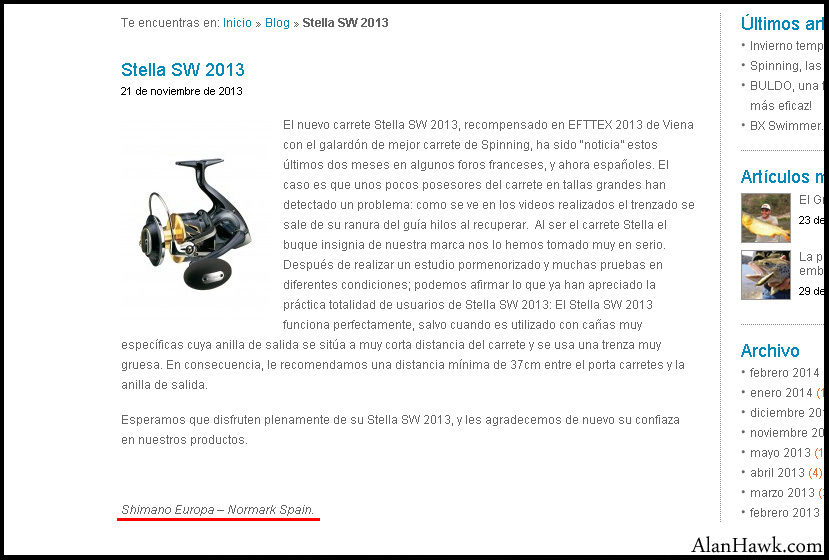 The gist of this statement is as follows
"There have been reports and videos from France and Spain of problems in the new Stella SW where the line would get out of the line roller, and following our investigation we found that this only happens with rods that has shorter distance between the reel and the first guide, therefore we recommend rods on which this distance is at least 37 centimetres to avoid the issue".
Without getting into the inaccuracies of this statement, I happen to have a large number of rods and when I tested the Stella SW I chose a couple that worked very well with the new parallel foot, but for others who only have rods built to standard dimensions it should be good news that Daiwa kept the traditional angled foot for the new Expedition.
Different approach
Before we move ahead let me tell you how and why this review is going to be different. Following my fishing and stress tests I sat down to disassemble the reel and examine it internally as usual, then I quickly realised that this reel shares about 60% of the internal parts with the 2010 Saltiga which I already reviewed, meaning also that it shares about the same percentage of parts with the 2011 Catalina which I reviewed as well. At that point I decided that instead of showing you what largely is the same parts for the third time, I will skip taking photos of the innards and do the review in a slightly different manner where I'll focus more on explaining how the design affects its real life performance instead of doing the same pictorial analysis that I've already done twice on the same parts. This would keep it fresh and free of repetition as well as save a lot of time typically spent on photo editing, watermarking, copyright management, etc. I will insert the few photos I had already taken when I first opened the box.
Drag
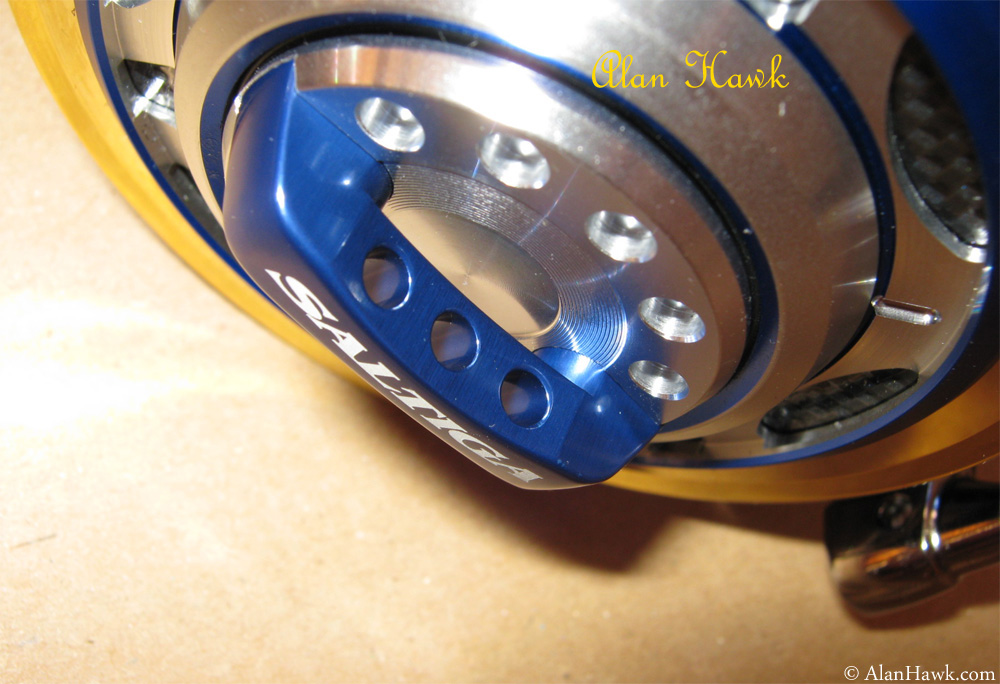 The drag knob is one of the majorly redesigned parts of this new reel. It's fully constructed of machined metal on the Expedition, while the drag knobs of the 2010 Saltigas and Dogfights have stamped metal components and a plastic outer casing. When I was trolling for bait fish on my way out, some small Wahoo and Bonito in the 2-3 kilograms range made a few short runs against the lightly set drag of the Expedition. As that happened I could immediately feel the drag knob becoming warm, something that I have never had happening on any reel with such light drag settings and small fish. Sounds bad? Actually it's the exact opposite; any run against a drag of a reel no matter how small will generate friction and heat, you want this heat to be ejected quickly, and this is exactly what the new drag knob of the Saltiga Expedition is doing radiating even the smaller amounts of heat quickly to air.
This is achieved through the full aluminium and stainless steel construction of the knob which facilitates the transfer of heat from the pressure disc to the outer surface of the knob in an uninterrupted metal to metal contact. For comparison the knob of the 2013 Stella SW has an outer metal casing and a metal pressure disc, but both are attached to a plastic frame that effectively insulates them from one another. It's true that in a Stella the larger drag discs are at the bottom of the spool, yet with the radiators of a Stella's drag being protected by the skirt of the spool while the radiation knob of the Daiwa is exposed to open air, I would venture to say that Daiwa's new system attains better results in terms of cooling and heat dissipation with the simplicity of a top stack drag. The knob of the new Expedition has drilled holes and a bridge type finger bar for more surface area and exposure to air. You can see in the following photo how the pressure disc is now a machined part integral with the flange with screws assembly, instead of the stamped metal that's clipped into the flange found in 2010 Saltigas.
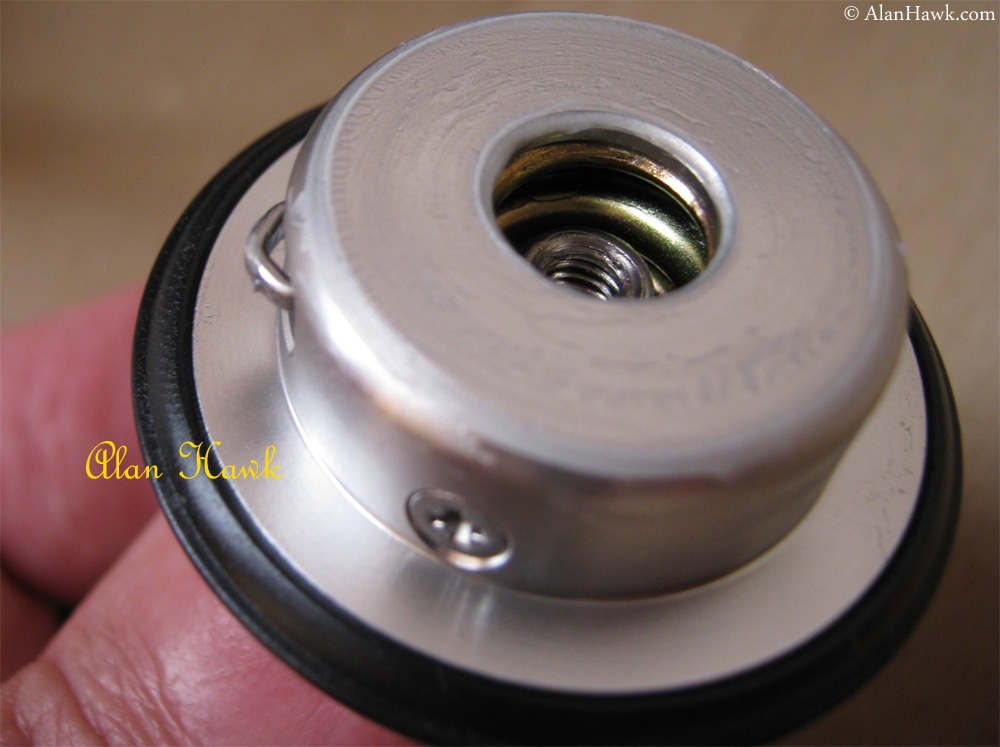 Still on the knob. In 2013 the new Stella SW came with a new wave spring inside the drag knob, a feature that I discussed in detail when I reviewed that reel. In a nut shell the wave spring of the Stella improves the consistency and smoothness of line release from the entire length of the spool, but it has a stiff feel even at lighter settings that makes it hard to tell how much drag is being applied since the spring lacks the usual progression feel. Since the two companies are always on one another's back with new features by one being responded to by the other, Daiwa made a change in the drag knob of the Expedition using a new proprietary designed coil spring made of a special alloy with a compression rate and behaviour close to that of Shimano's wave spring. This drag knob and a special washers' grease designed to perform under higher pressure and heat form what Daiwa calls "UTD Hyper Tuned Drag". I definitely hate these rubbish commercial catchy names, but the system does work making the drag of the Expedition liquid smooth with even the slightest perceivable fluctuation gone, in addition to being so responsive it almost feels unrealistic. Based on my own senses I believe that Daiwa's response surpasses the result achieved in the 2013 Stella, and the Expedition's spring remains a coil spring that retains the natural progression and feel we're familiar with.
The Expedition uses the same drag washers of the 2010 Saltiga and Dogfight, but the new spring changes the maximum drag. On the water I did not come anywhere near maxing the drag with the highest setting actually fished being about 17kg (37 lbs) which I used to land a Mediterranean BF that we estimated boatside at ~110kg (~240 lbs). I usually don't fish that much drag but it was dark and my host was uncomfortable with the sea condition in our small boat so the fish needed to be landed quickly so we can go home. This reel needed dry land scaling to find its maximum drag, and that was an unprecedented 32.8 kilograms (72.3 lbs). This is the highest actual drag I have ever recorded on a spinning reel, being way above that attained by Stella SW 20000 and 18000, TwinSpin 30 and 50, and nearly twice as much as that of the Stella 30000. This is nothing but a shameless flexing of technological muscles by Daiwa because this ridiculous amount of drag is never going to be utilised in an actual fishing scenario. Forget the delusional people who tell you that they fish 25kg of drag standup on spinning reels because these are lies. I have one of the strongest back muscles on non-steroid users and I do one hand rows with a 63kg dumbbell strict form, yet the handful of times I fished around 22kg of drag in the past I was badly shaking and wouldn't keep it up for more than 1 minute at best. The maximum most fishermen could realistically handle standup is no more than 15kg, so when using the Expedition 8000H at your maximum you'd only be utilising %45 of its actual abilities. There isn't a good reason for me to complain about that amount of maximum drag, but it's just redundant in my opinion.
In the past I used to evaluate a drag based on how much starting stickiness it has, the possibility of a lockup, or the chances of parts melting. Now though reel designs and technology have moved past that and such concerns only apply to lower end reels, therefore these days I look for completely different things in the drag when I fish a high end reel, one of which is heat management. The heat dissipation of the Expedition's drag doesn't only depend on the drag knob. Rather the spool's entire design is geared towards that objective with its thin walled metal and the heat sink area in its backside. This in conjunction with the new knob assured cooler than usual operation throughout my tests that even during longer fights at up to 13 kilos (28.5 lbs) of drag the spool stayed warm at most never coming near what I would describe as hot. On a different note I find the carbon fibre washers of the Saltiga to be more durable than the washers of the Stella, which while not related to performance is still an advantage since one gets a longer service life out of a set of Saltiga's washers. My final word on the drag of the Expedition would be that it's without a doubt the best available in the world today, successfully responding to the improvements by the competition and pushing the performance to yet new grounds in all aspects of its function.
Spool hub and main shaft
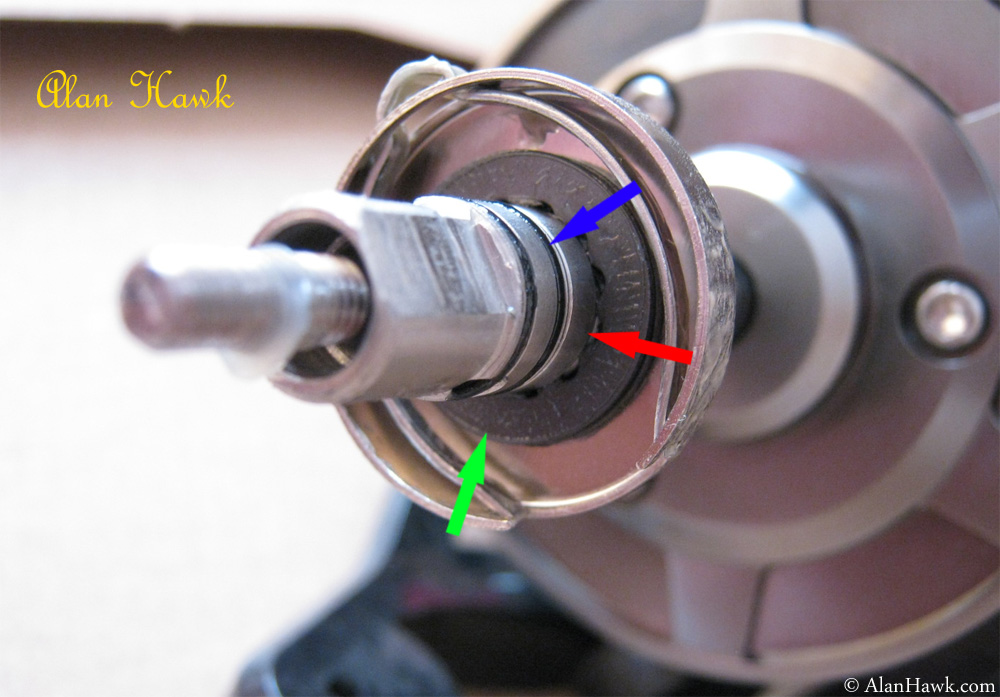 The spool hub with the second spool ball bearing (red arrow), and the O ring bottom spool seal (blue arrow). An advantage of this bottom sealing is that the spool of the Saltiga spins against the resistance of just two tiny O rings, unlike other designs where the spool turns against more friction by larger seals on its bottom. Spool shims (green arrow) are still that same design that makes it a PAIN to add or remove shims and limits the number of shims that could be added or removed. My Expedition lays line beautifully out of box, and Saltigas in general rarely need adjustment of shimming because the drag washers are on top where they won't affect the spool's position with washers wear and compression, still, I would want more flexibility in adding and removing shims in the Saltiga because I might need to tweak the line lay for one reason or another.
The Expedition has the same shaft as the 2010 Saltiga. This shaft is a full round bar of stainless steel without side cuts, so it withstood the higher maximum drag without an issue. A drag force generated by the spool means nothing if the reel as a whole can't handle it, therefore many of the drag numbers advertised nowadays are garbage since the reels would collapse before reaching those numbers.
Rotor
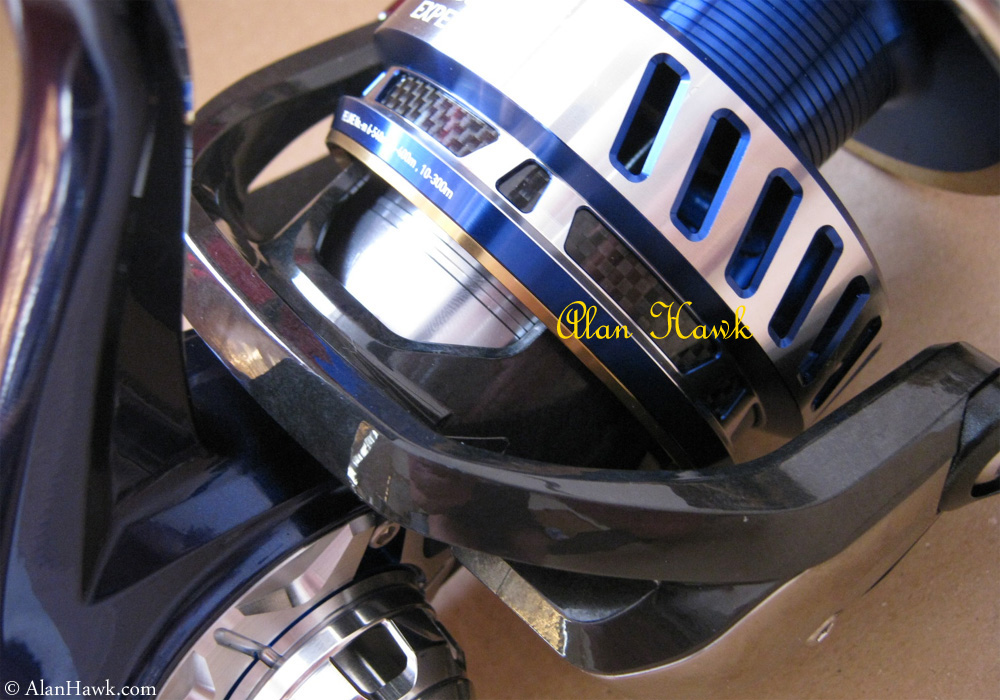 When I tested the Saltigas in 2010 I harshly criticised the flexing of the Zaion rotor which, despite being a controlled flexing, was just not right. It lacked the feel of rigidity, and the more experienced fishermen would have noticed how that flexing absorbed some of the force when a fish made a run, making the drag less responsive to sudden movements. When I first held a show sample Expedition earlier this year though I could tell that something was different as I squeezed the rotor arms in my hand and didn't feel the expected flexing, and now I know that the material is different. What happened is that a few years ago both Japanese companies came up with their carbon infused composites, one calling it CI4 and the other calling it Zaion. As is the case with any new concept there is always room for rapid improvement after the initial debut, and both companies did just that. Shimano improved the CI4 and came up with the new CI4+, and Daiwa quietly improved their Zaion without renaming it. Here is how Shimano describe their CI4+
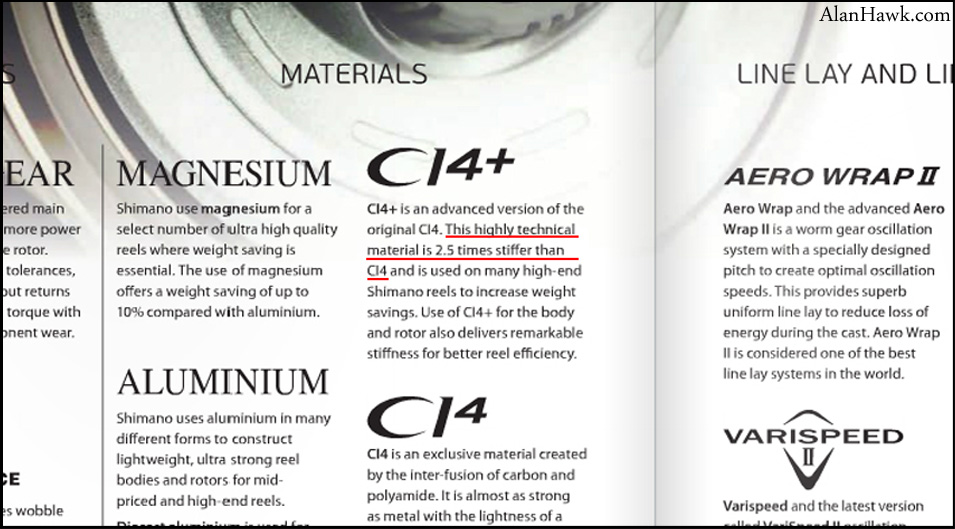 While I can't say for sure how many times the new material is stiffer than the old one without controlled laboratory deflection tests, I can confidently say that both the CI4+ and improved Zaion are at least twice as stiff as the old versions. As usual, Daiwa tested this improved material on other reels first, and now it makes its way to the flagship saltwater reel with very satisfactory results. The rotors of the new Expedition flex less than the metal rotors of the other top reels under the same load, and the improvement is quite easy to notice. That doesn't mean that the Zaion is as solid as metal since the sections here are thicker than sections of metal on other reels, rather it means that it has improved quite enough to be able to perform better than metal with the right design. The rotor of the Expedition handled the drag tests at 32.8kg superbly. Well, as much as the traditionalist inside of me hates these new plastics, at this stage objectivity compels me to give up and acknowledge that they have become so good that I no more have a valid argument against them and I can only praise their properties such as the impossibility of corrosion, absence of fatigue over time, and of course the lightness and low inertia that make rotation exceedingly light. Less energy wasted on overcoming the static inertia of the rotor means more energy transferred to whatever is at the end of the line. I personally believe that the rotor of the Expedition has found the sweet spot of having low static inertia yet maintaining proper momentum when turning, something that's pretty essential when retrieving and playing lures.
One thing that's hard to deny about Daiwa is that they have always been the ones who set the trends then the others follow, and this rotor is good witness to that. The centre cut in the rotor was Daiwa's brainchild back in 2010 on the Certate and Saltiga, then look at what followed
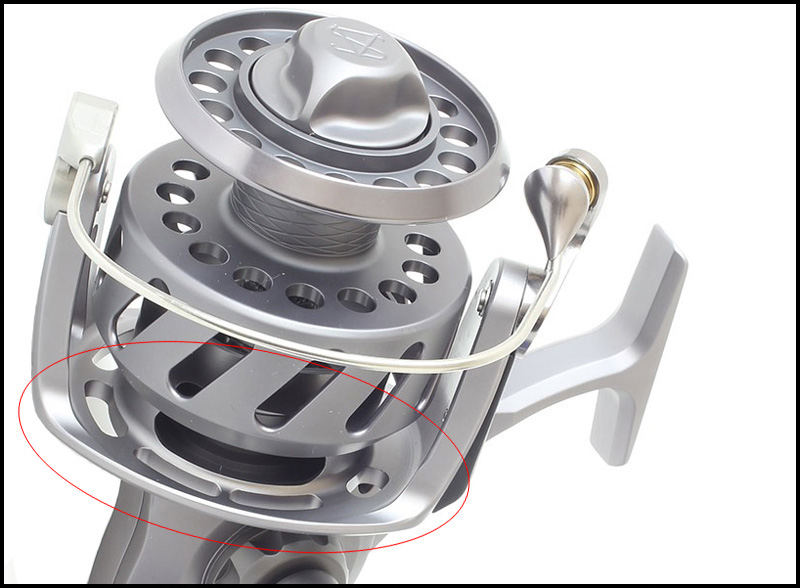 Van Stall VM275.
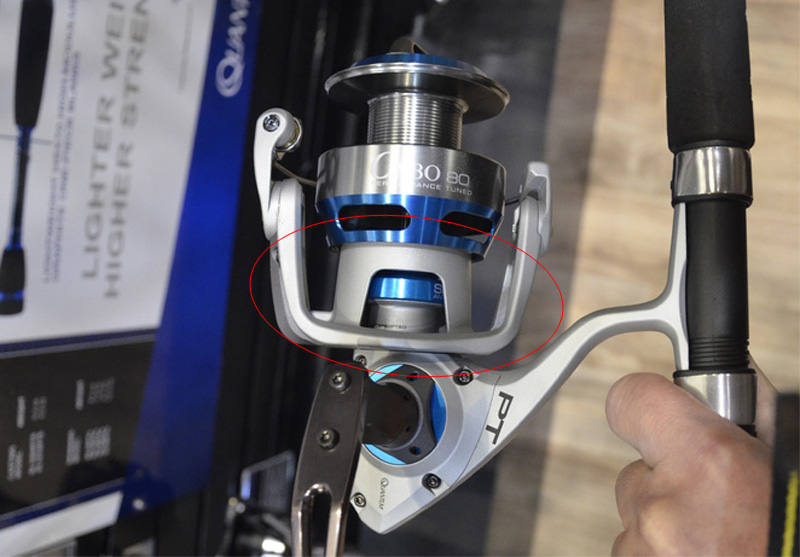 Quantum Cabo (and a few other Quantum reels).
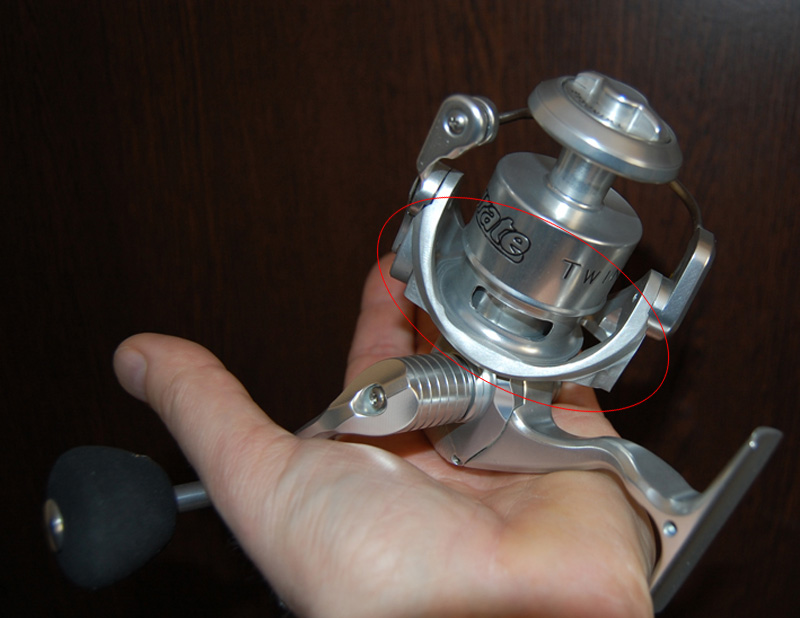 Accurate's TwinSpin SR6.
These are just a few examples from known brands, but there are many more. Daiwa's engineers decided that with better distribution of stresses on the rotor arms they can cut out some excess material in this area, and soon others in the industry copied their sound engineering to varying degrees. While fishing tackle companies have always copied ideas from one another, Daiwa deserves a nod for being the one that comes up with the most significant design concepts. The 2001 Saltiga came out with the one piece bail wire seven years before Shimano adopted it for the Stella and others followed, Daiwa came up with the mechanical backup anti-reverse that has since been copied by Shimano and other brands, the Saltiga was the first reel to have ball bearings on the oscillation slider before others followed, and of course the original Saltiga was the first fully sealed boat reel long before it became a standard feature in most top reels.
Note- the three photos above are not mine and credit goes to original photographers. As a rule my own photos and captures are always watermarked and have my copyright sign, others are reader submissions or collected material used for illustration purposes.
Mag-seal
The timeline goes like this; in 2010 I reviewed the Saltiga and gave the new mag-seal a merciless thumbs down, then in 2011 when I reviewed the new Catalina I said that the system has improved significantly, and now examining the Expedition three years later I can say that the mag-seal has finally been perfected. Not only that the magnetic fluid stayed where it's supposed to without splattering, but the fluid also remained completely clean despite the reel having been contentiously drenched by heavy sprays of saltwater in speeding boats and being fully submerged in freshwater in later testing. Since the early Saltigas Daiwa has reworked the magnets and the fluid itself and the result is pretty impressive.
In the past this system was too flawed for anyone to objectively evaluate its merits, but now that it works fine I can finally do it. This is another one of Daiwa's inventions where a propitiatory designed unit containing a calibrated magnet fits around the pinion, and in the space between them a magnetic fluid is suspended to form a seal that keeps water out but without any friction since there are no rubber seals or physical contact between parts. Mag-seals though come with two precautions; the first is that the reels shouldn't be used for surf fishing where the water has suspended sand and solid particles which could get caught in the magnetic fluid, and the second is that only Daiwa's official service centres can do a full service of the reels because Daiwa does not sell the magnetic fluid, meaning you should only buy mag-sealed reels if you have local Daiwa service centres that accept your particular model for service. With these precautions heeded, the mag-seal is certainly a pioneering feature for a fishing reel, being the world's only resistance-free waterproof seal.
Clutch
This is the same Japanese made anti-reverse clutch that Daiwa has constantly used since the mid 1990s beginning with the flagship Team Daiwa X reels that preceded the first Saltiga. For nearly 20 years this clutch has performed with utmost reliability, and it's just normal to see it present in this latest generation. This clutch with its 6 brake stainless steel pins each operated by an independent metal V spring performed as it should, and certainly is one part that has nothing left to prove.
Beneath the clutch sits the main ball bearing which fits tightly in its recess without any play. As I mentioned when I reviewed the 2011 Catalina, the retainer of this bearing has been strengthened since my early 2010 Saltiga and has since been working flawlessly.
The body
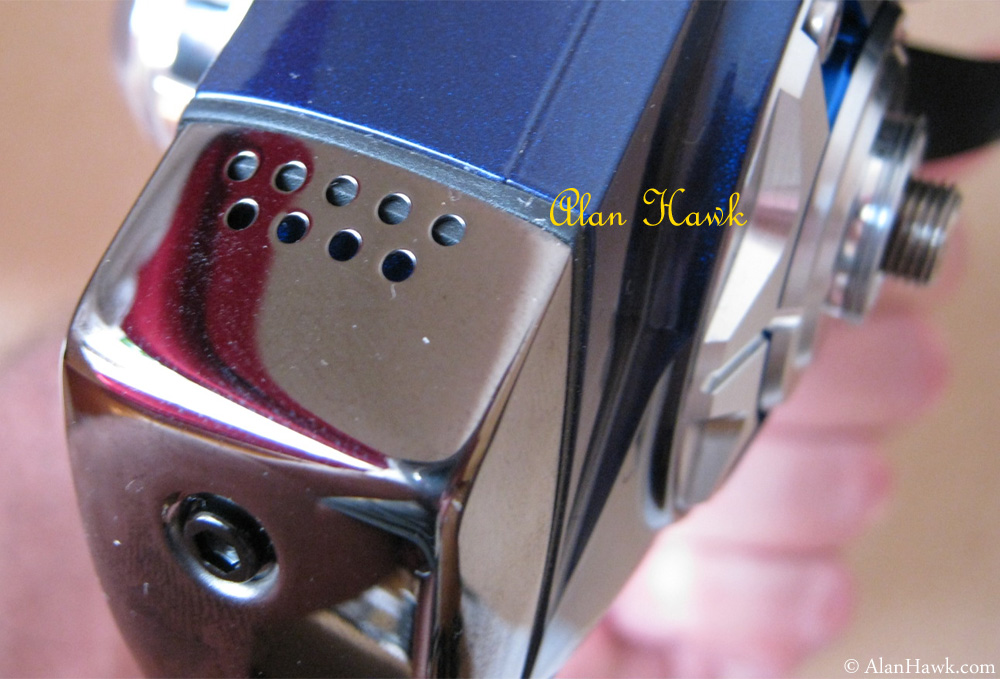 Another important change in this generation is the addition of draining holes in the body bumper. This way any water that gets behind the bumper could drain out harmlessly instead of becoming trapped and corroding the finish. I personally never had water behind the bumper on any of my 2010 Saltigas, but cases were reported where this has happened and obviously Daiwa has responded with this upgrade. This body shield of the Expedition is made of hardened stainless steel, and I still find it as classy and luxurious as I did when I first reviewed the Saltiga four years ago. It's made of plastic on the Stella SW, and this stainless steel bumper of the Saltiga is one of the elements that give the reel that unique solid feel.
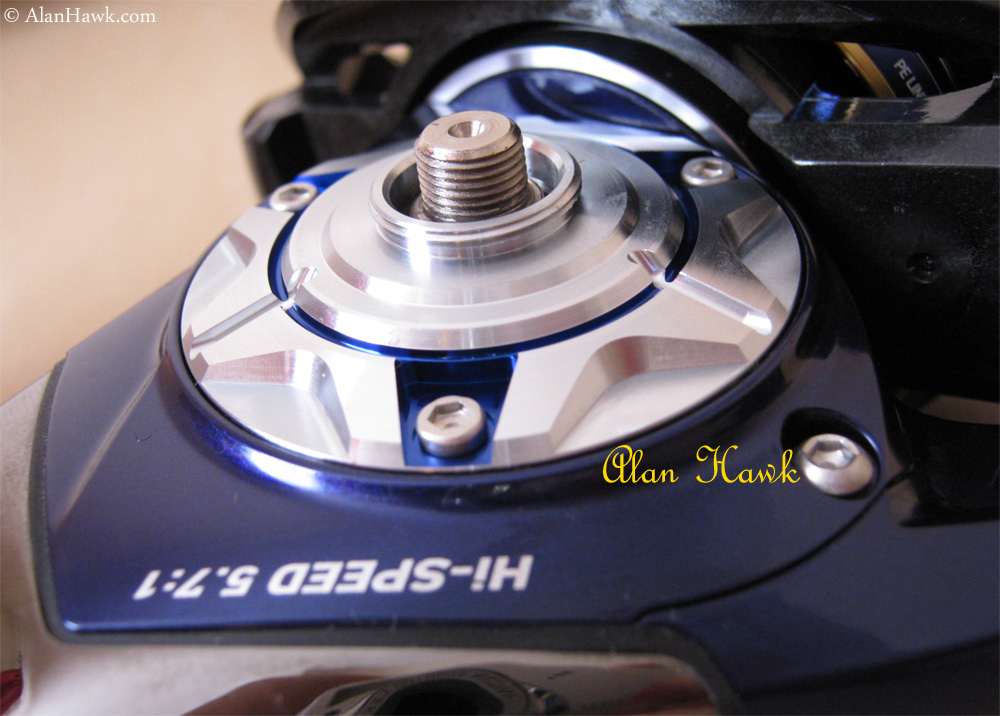 One of the two body inserts that Daiwa calls the "engine plates". This insert is precision machined, and therefore aids in the accurate fitting of the gears. In this photo we see the first element of one of the most significant changes in this reel; the black rubber seal that used to protect the handle's opening is gone. In the 2010 Saltiga/Dogfight and 2011 Catalina/Isla reels, that seal was mounted on a special recess machined into the plate to do the waterproofing of the handle's opening. It worked pretty good, except that it had the bad habit of falling out and getting lost when the handle was unscrewed at the end of a fishing trip, and of course it created friction since the rubber was in constant contact with the handle's shaft. It's gone in the Expedition for a friction-free rotation and was replaced with internal sealing that you will see in the next paragraph. Now that the rubber seal is gone, you will need to add an extra task when cleaning the reel after fishing, by removing the handle and letting freshwater enter this opening gently to remove any saltwater deposits inside.
Gearbox
Before we get to what's inside the gearbox, I need to warn you that the screws of the side cover were surprisingly tight. These screws have a close fit to the threads, a thread locker was applied at factory, and they were tightened to what I believe is the very end of the allowed torque limit. This means that only quality tools should be used to remove them, the tool must fit perfectly, and you should have a stable and firm grip as you do it. Do not use generic Chinese made keys for this job because the steel used in these Chinese sets is usually rubbish and will deform inside the head or deform the head itself leaving you with a stuck screw. Use a quality set of German, US, or Japanese made keys, or if you can find and afford "Swiss Tools" branded ones get them as they are of an outstanding quality.
The first thing that catches one's eyes inside the gearbox is the two new mag-sealed ball bearings, which replace the old bearings on both ends of the drive gear's shaft. First, let me quickly describe the most common types of bearings found in fishing reels. We have the open bearing, where the balls and cage are fully exposed without any protection. We have the shielded bearings, where a metal shield is attached to the outer race providing protection from larger contaminants but not water or oils. And we have the sealed bearing, where a rubber gasket fully seals the bearing and provides complete water protection, but since the rubber gasket is in constant contact with both races it adds resistance and heft to the rotation of the bearing. Daiwa's mag-sealed bearing is a completely new concept though
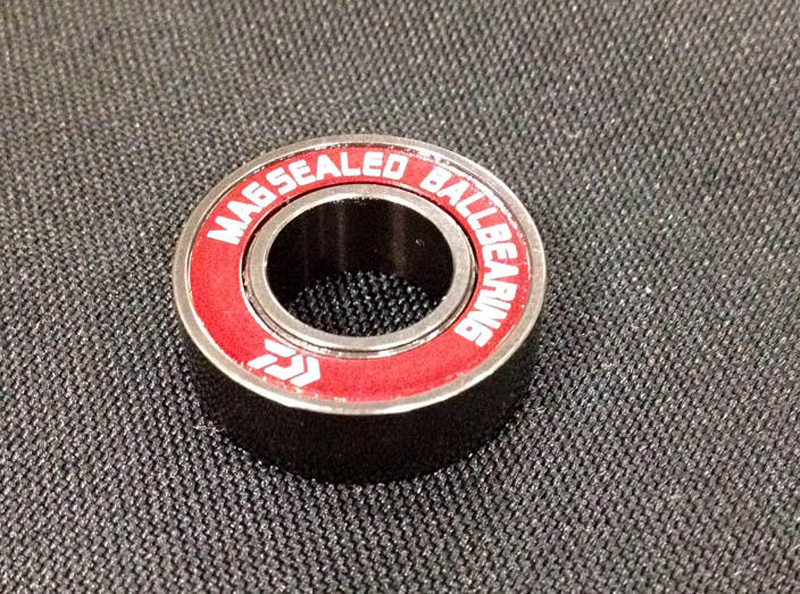 Here is a photo of a demonstration one. These are Japanese made corrosion resistant ball bearings, the shields mounted on them each carries an integral magnet, and in the small space between the shield and the inner race of the bearing the magnetic fluid is permanently suspended in the force field of the magnets. This way the bearing is fully waterproof, but without friction or drag because there are no rubber gaskets or physical contact. I really wanted to pop the shield out and look at the internals, but this is a well balanced system that needs special tools to disassemble so I decided not to mess about. These bearings are the internal sealing I spoke of in the previous paragraph which makes the old rubber seals of the handle redundant. How effective is the sealing of these bearings?
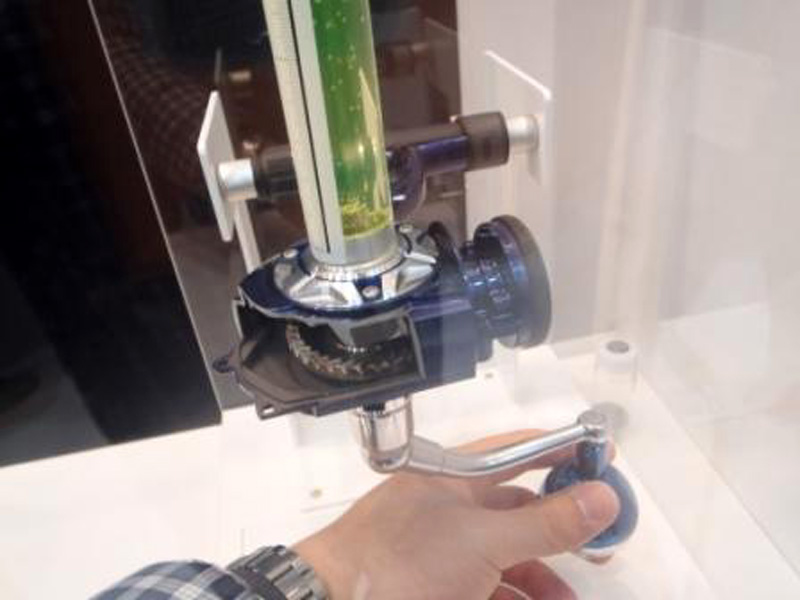 Daiwa put this hands-on display in a couple of fishing shows where a tube of pressurised water is mounted on the handle's opening of a new Expedition, and people are asked to crank the handle and see that no water leaks inside. I don't have the tools to replicate this extreme test, but my reel spent the night before the disassembly in the bottom of my fish tank, and I found no traces of water inside the reel. These things do work.
As is the case with all Saltigas, the Expedition is a fully waterproof reel, therefore the side cover has a seal that goes around the entire perimeter of the gearbox. This seal fits snugly in its dedicated channel without any looseness.
Oscillation
The oscillation system hasn't changed from the 2010 Saltiga/Dogfight reels. The same durable locomotive design comprising two gears connected via a pressure spring to eliminate any play in the system, working in conjunction with the curved channel in the oscillation slider to produce the well timed movement of the spool responsible for the exceptional line lay. The oscillation slider has double ball bearings on its lower side to roll smoothly under heavy loads, and on its top side there is a roller with a rubber ring to eliminate shaft rattle and make the oscillation stroke virtually silent. As in the 2010 model, the stud that connects the top oscillation gear to the slider has a rubber ring to further dampen noises and prevent play, and it is worth mentioning here that Shimano has copied this feature in their new Saragosa SW and Spheros SW reels.
Actually there is one change in this setup. If you recall I highlighted an issue in both 2001 and 2010 Saltiga reels where the bottom oscillation gear would leave rubbing marks on the finish beneath it after a short amount of use, but in the Expedition I saw no trace of this issue. The oscillation gears of the Expedition feel perfectly stable and the internal finish of the body seems more resistant, but whether it's one of these reasons or something else the issue didn't appear in this reel. I can't tell whether it would appear after a year of use or not, but the Expedition has been fished harder than the 2010 reel had been when that older Saltiga first developed this issue, so there is certainly an improvement here.
Gearing
Again there are no dramatic changes here. Daiwa retained their C6191 marine bronze drive gear. An alloy of 85% copper with additives of Iron, Nickel, Manganese, and Aluminium, the C6191 has a tensile strength of around 850 mega-pascal which is nearly twice as much as that of Duralumin. Despite being expensive and costly to machine, its strength, low coefficient of friction, and corrosion resistance in marine environment make it a most perfect choice for this job. In the 8000H this drive gear is coupled with a pinion made of a marine bronze alloy similar to C6191 but with higher nickel content and silicon for superlative strength, while in the 5500H the pinion is stainless steel. The gears of the Expedition are formed by numerically controlled cutters following a computer created and analysed 3D model, which creates very accurate parts for optimum teeth meshing that's otherwise unattainable. The original gear of the 2001 Saltiga had a relatively small diameter, but for the 2010 model Daiwa enlarged the gear to give the system a distinct advantage in efficiency, and in addition to that it received further improvements of its geometry, mainly focused on altering the teeth to optimise the pressure angle and reduce axial force which tries to push the gears out of mesh during operation. Without getting too complicated, this improves power transmission efficiency even further and reduces energy loss to sliding and negative forces. Of course the biggest advantage in efficiency in a Saltiga's gearing comes from the male gear shaft which is thinner than the hollow female gear shaft of the competition, allowing the drive gear of a Saltiga to be positioned closer to the main shaft than in any other reel with a hypoid gearing. Smaller gear offset = more gear efficiency. This improved gear of the 2010 Saltiga is used in the Expedition as well, but a little alteration was made to its axle to accommodate the new mag sealed bearing, therefore the gear of the Expedition is not interchangeable with the 2010 Saltiga or Dogfight. With this high gearing efficiency, the resistance of the old rubber seals gone, and without energy loss to rotor flexing, one can really sense the peerless pulling power of this reel. This power doesn't only show when you're fighting a fish. I cast poppers and played heavier jigs in 130 metres deep water, and while I had zero hits on poppers and jigs, I could still feel the excessive power making it much easier to drag a flat faced popper across the surface or play a heavy jig with this fast reel without becoming exhausted.
I tried to punish the gears as harshly as I humanly can. My target was to hook a good number of bluefin tuna in the 150kg range which are plenty in Western Mediterranean where I was invited to fish, but as a one-man operation I will not always succeed in doing what I planned, and unfortunately this is one of those times. Due to a late release date, scheduling conflicts, and an annoying transportation incident, I only managed to squeeze in three days of tuna fishing late May and early June, during which I only hooked three proper BF the smallest is about 85kg (175#) and the biggest is the 110kg (240#) one mentioned earlier. Nevertheless I tried to make it up as much as I could in mid June when I fished more familiar waters and with the aid of live bait pulled some big groupers from the deep up to 80 kilos (175#), and while I didn't target sharks I kept accidentally hooking them for some reason. I guess those blacktips just found my tail-clipped blue runners irresistible. I did my best to punish the reel on the water and afterwards with a torture test that I'll explain later, yet the gears seem quite unaffected, obviously needing much more work to begin to show any signs of wear that I can pick. It's safe to say that this gearing is another part that has nothing left to prove, especially with many of the 2001 Saltigas still running the original gears tightly 13 years later.
A final thought on gearing in general. I usually see posts by anglers concerned about handle play (or gear backlash) on their new reels of various brands, and because of a general lack of understanding of mechanics they often receive rubbish answers and are told that they have a problem. In reality properly functioning gear systems require a clearance (or play) to avoid wear, excessive friction and heat, and a phenomenon called interference. In spinning reels a larger amount of play is needed to also compensate for manufacturing tolerances since there would be inconsistencies in teeth heights, width, pitch, and even the thickness of a gear plate. The play is built into the reel so that when you turn the handle the gears would have this clearance to move in and out and jump over these inconsistencies. If the gears are fit tightly you'd feel spots of roughness and teeth digging into one another. The more accurate the gears are manufactured the less play they will need. For example mid range and high end Shimano reels generally have more handle play because their gears are cold forged, which is a brilliant manufacturing technique to create strong gears out of a lighter and softer alloy, but it produces less accurate parts than other manufacturing methods therefore they need more play built into them to function properly. On the other hand the gears of a Saltiga are manufactured significantly more accurately than other reels, hence they need much smaller play that is so hard to notice many anglers actually think they have zero play. I'm writing this here because I believe that some people could be using Saltiga's lack of perceptible gear play as a benchmark, so when they compare other reels to it they wrongly conclude that the other reel must be faulty. Gear backlash in spinning reels is normal, so next time you buy a reel and feel some handle play just relax and go fish because it was made this way.
I digress...
I would like to use this space to elaborate on that "transportation incident" I mentioned two paragraphs earlier and give you a heads up. I had my Expedition in my hand luggage as I went through security barely 50 minutes before a flight, and as my bag emerged from the X ray machine it was pulled aside for a manual search. The guy proceeded to open it while asking me about the "heavy metal object" I had in there, and I explained that it's just a fishing reel that isn't in any way a heavy object. He looked at it and consulted with someone else who seemed more confused than the first guy, then he told me that I can't fly with it and that it needs to be checked in. I argued that at nearly $1500 this was more valuable than any laptop and that I wouldn't risk it, I said that it poses no danger and that I always fly with reels, but all to no avail. I was asked to wait as they enquired around and tried to get a hold of a senior security officer, and I kept trying to connect to the internet on my phone to show them proof. Unfortunately though by the time I finally managed to download the rules on hand luggage and show it to them it was too late and I had missed my flight.
My own fault here because I used to carry a print-out of the TSA's cabin luggage rules, but for some reason I'd become too complacent and wasn't carrying one this time. My advice to you if you fly with reels is to first make sure you don't have line or hooks in your hand luggage, then search TSA's website for "fishing reels" and print the instructions then take the print with you to the airport. Here is a screenshot of the curent version
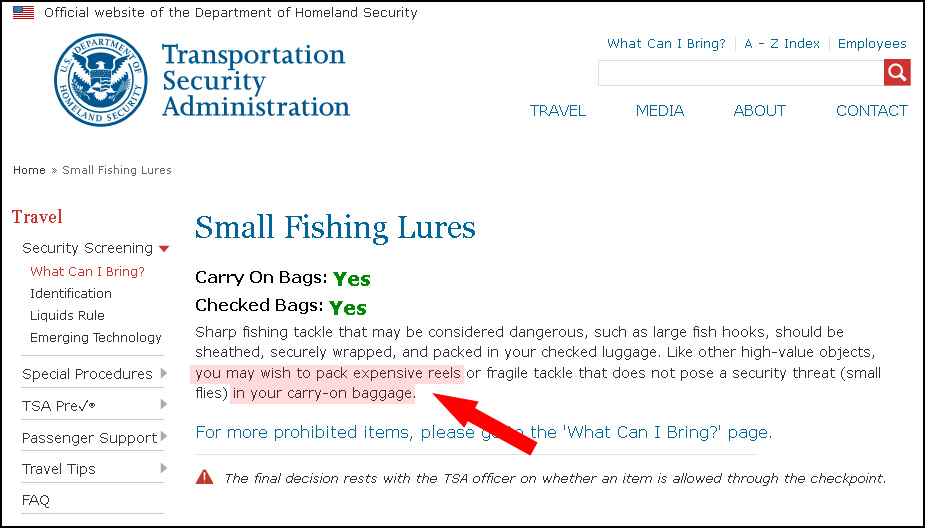 If confronted, show the print to the airport security personnel in a firm but polite manner. Firm in the sense that you know your rights and that you're holding on to your reels, yet polite in showing the evidence in a respectful way. Don't act as if you're lecturing them or as if they don't know how to do their job because after all they're humans who could take it personally and take you through intrusive bodily searches or similar rubbish that they're perfectly allowed to do. Of course TSA is responsible for transport security in USA's airspace, but their printed rules should work anywhere because if TSA's rules -which are the toughest in the world- allow reels on board then any other country should not have a problem with that. Anyway, I'm not naming and shaming because I received a proper apology and was put on another flight and given vouchers to eat while I waited, still I lost 10 hours which had a domino effect on my arrival and accommodation arrangement and naturally on my fishing plans, so I thoughts this paragraph could help you avoid similar heartache.
Back to gearbox
Well, we're about done in there. The mechanical backup anti-reverse is the same design from the first and second Saltigas, and overall Daiwa seems to have settled on a stable design of the gearbox with the general design elements remaining the same since 2001. In that same amount of time Shimano changed the material of the pinion in the Stella from brass to stainless steel then back to brass, changed the finish of the drive gear, put a secondary set of gears in the oscillation system of the FA, removed it for the SW, then put a different set back in the SW-B. In my opinion Shimano should have settled with the internals of the 2008 model since they were the best they had, but it's their call and not mine.
Line Roller
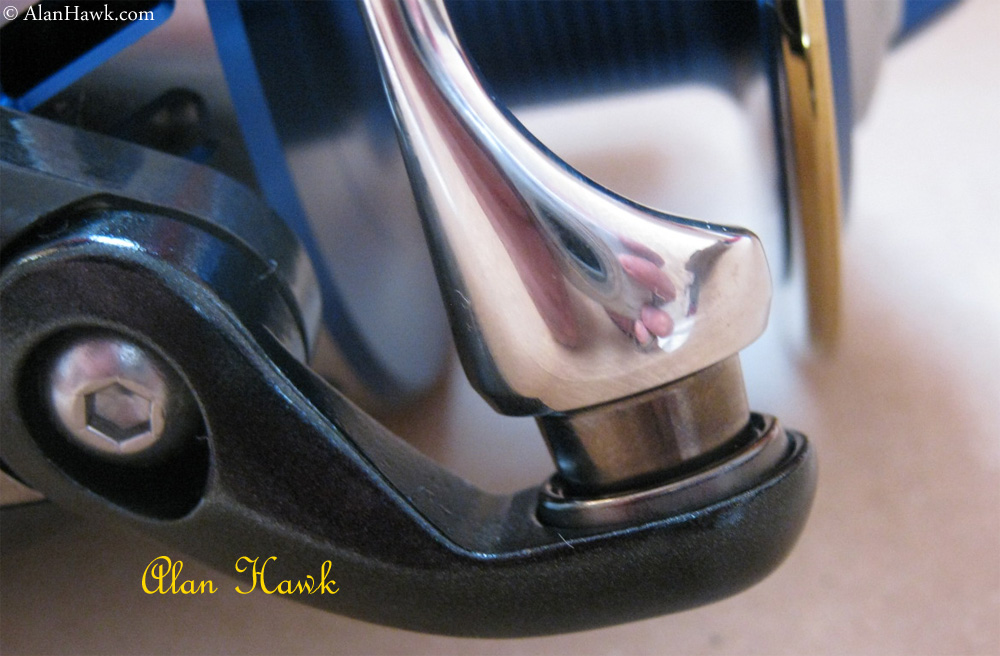 The line roller of the Expedition is mag-sealed as well. Instead of two rubber seals at both ends of the line roller as in the 2010 Saltiga, the line roller's ball bearing in this 2014 model is protected using the same magnetic sealing concept used in the the pinion and the drive gear's bearings. It goes like this; there used to be two ball bearings in the roller of the Saltiga, for the Expedition these two were replaced with a single heavy duty bearing that has two shields with a miniature circular magnet mounted on each. These magnets create a magnetic field between themselves and the inner race of the bearing on both sides, and the magnetic fluid is suspended in this field to provide waterproofing without physical contact or friction.
I wanted to give this roller seal some memorable abuse, so after fishing I decided to give it 1 million spins to see if there will be any issues. Knowing the circumference of the line roller and using a simple division I got the total length of line that needs to be spooled in order for the roller to spin 1 million times, and since I decided to spool that line against some pressure to torture the gears as well it took me a morning and an afternoon with little breaks to complete it. You already know that the gears remained in top condition following this experiment, and I can report that the line roller and its sealing were just fine. As usual they tested this system in smaller reels before incorporating it into their flagship saltwater reel, and they obviously learned from the reported issues in the 2012 Exist and refined it well enough to work reliably in the Expedition. I need to remind you that when cleaning or lubing the Expedition or any other reel with a mag-sealed line roller, no oils or solvents should come near the roller since these substances could alter the composition of the magnetic fluid. Water is the only thing that should come in contact with any areas where magnetic sealing exists to avoid ruining it, so only rinse these parts.
One has to say here that the way this reel is built gives it a particular sense of exclusivity, seeing how parts such as the 4 mag-seals and the new drag spring are all proprietary parts designed and manufactured especially for this reel. The quadruple magnetic sealing in particular gives this reel a most unique characteristic in terms of free spinning. The handle is so sensationally light to turn it forces you to adjust what you already knew about free spinning because this is something else. Creating the freest and lightest-rotating reel in the world is one thing, but doing it while maintaining 100% waterproofing down to the line roller is a true technological feat. Of course when comparing things such as free spinning or pulling power to other reels one has to compare the Expedition to similarly high speed reels. Low ratio jigging reels by nature produce more torque and feel differently.
Bail
The bail is the familiar hollow stainless steel tube, 4.5 mm thick on the 8000H. Bail wires on Saltigas are proportioned to the reel's size, so smaller reels have a wire that's only 4 mm thick. Not all brands do this. The bail arm of the Expedition is well fitted and its fastening screw has a firm stop in the new stiff Zaion material, and the bail opens considerably wider than usual to allow big coils of line to fly freely without hitting the wire. The action of the bail itself is both buttery smooth and mechanically sound. The resistance of the spring is intuitive throughout the opening motion, and when you reach the toggle point the spring reverses and snaps the bail fully open and engages the rotor brake by itself. In the larger 2013 Stella SW reels the bail needs you to continue pushing it past the toggle point to engage the brake, and when you close it there is a point of felt resistance as described in its own review.
Rotor brake
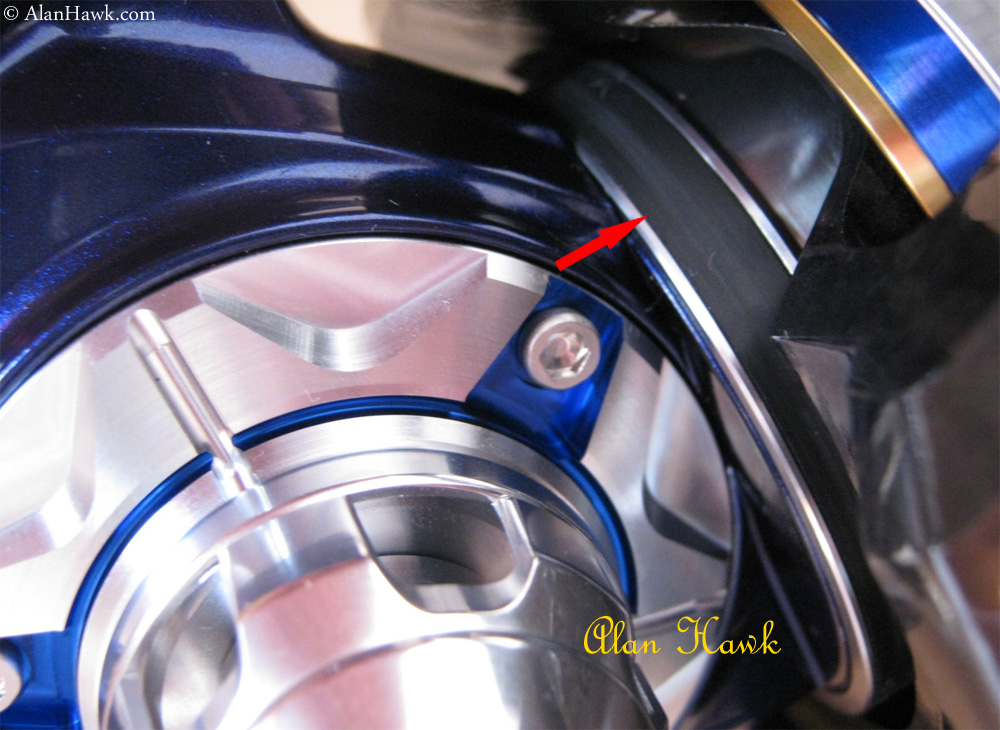 This is the mechanism that keeps the rotor still when you open the bail to cast. When this external brake ring (red arrow) first appeared in the 2010 Saltiga I wasn't sure what to make of it, but years later it has become one of my all time favourite features. It's easily accessible for an oil rub every once in a while, and this keeps it in great condition for much longer than hidden ones in other reels which dry out then crack and need replacing every about a year or so of frequent use.
Handle
The handle of the Saltiga is same trusty jointless design for a straightforward attachment to the reel without struggling with a hood that slipped down the threads. The Expedition comes with a metal round knob as standard, leaving no need for any upgrades or accessories.
Finally
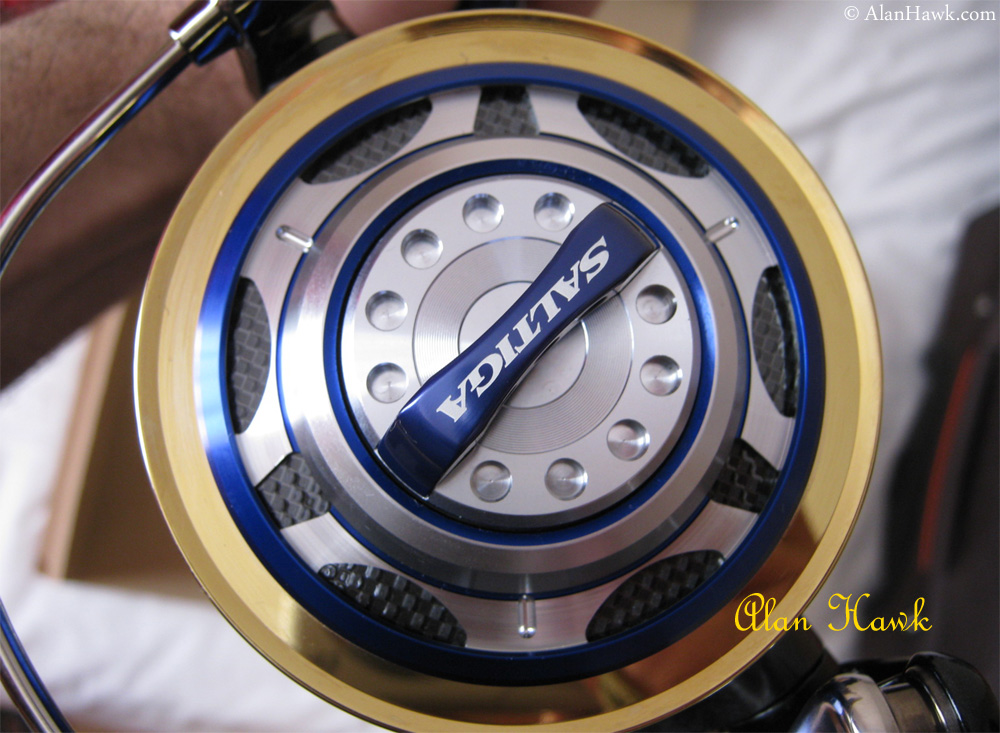 Last but not least, the cap of the spool is full metal, as opposed to the plastic one introduced in the latest Stella SW (except for the 30K). Some of my German speaking readers might have seen the statements by a person who adamantly insists that I got it wrong and that this part is metal on the new Stellas, and while I can't really smash one on camera to prove that it's plastic, I can show you the following photo of a 2013 Stella SW
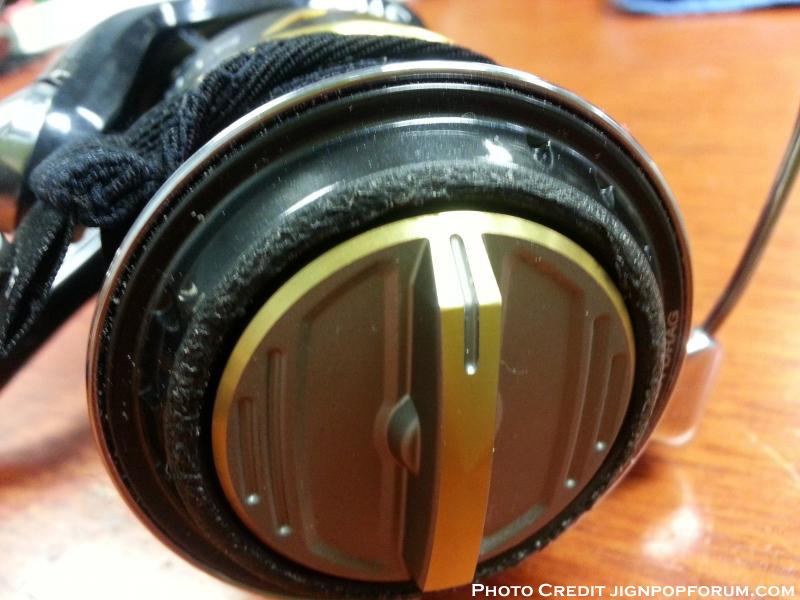 The plastic spool cap has melted on this Stella because of an incident during machine spooling. There is nothing to worry about here because it was something that's highly unlikely to be replicated during fishing, but this photo should prove that it's plastic indeed as I said.
Conclusion
Traditionally the biggest spinning reels commonly available were what I call "full size" ones. That is Penn's 8500/9500 size class, Daiwa's 6500/7000, Shimano's 18k/20k, and Accurate's 30 class. In the past few years though with spinning reels asserting themselves as a dependable tool for big game fishing, a new "mammoth" size class has appeared with reels such as the TwinSpin 50, Stella 30000, Spinfisher 10500, Omoto/Mantikor Big Block, and I'm aware of at least two more upcoming reels in this gigantic size class. With their huge rotors and spools these reels offer incredible line capacities, but not much in terms of user friendliness or fishability. Big rotors come uncomfortably close to the rod and your fingers, drag force is usually lower than their smaller full size counterparts, and with weights of 1 to 1.25 kilos they certainly aren't fun to cast or play lures for half a day at a time. The Expedition 8000H delivers a package of capabilities that exceed everything those mammoth reels have to offer, but it does it in the manageable classic full size and even weighing less than a Stella SW 20k. Normally the only thing that the 8000H loses to mammoth reels is line capacity, but in all honesty if I can't stop a fish with the Expedition's capacity of 600 yards of PE6, which is 90 lbs test for quality lines such as Sunline Monster Battle, then that fish has certainly earned its freedom in a fair chase.
Build quality wise, you probably know by now that my obsessively sharp eye is capable of spotting the slightest manufacturing imperfection be it 0.2 mm of bad tolerance here or there or a barely visible metal shaving left in the deep darkness of a screw head. I looked as hard as always, and found nothing at all. All parts fit properly, the metal finish is exemplary on visible and hidden parts, lubes and thread locker applied correctly and accurately, and all rubber seals are of a superb quality being made in Japan by NOK which produces some of the highest quality seals available anywhere in the world. I have seen faultless manufacturing before, but nothing like this reel.
Design wise, this is a mature reel. All the revolutionary stuff were introduced in the 2010 Saltiga, and the Expedition is the grown up and perfected version without the teething issues of that previous generation. The mag-seal technology has been mastered then expanded to other points of friction, Zaion material is vastly improved, plastic knob turned into a heat ejecting metal one, the stainless steel body shield gets a small yet beneficial upgrade, etc. Overall the reel progressed and developed in the natural direction one normally expects. This totally differs to the Stella SW which gained weight, received more plastic than ever, got a softer pinion, became tighter to spin, and of course it came with a considerable increase in price. In my opinion Shimano went the mobile phone industry way, where a 2015 model would be designed intentionally with things left to be desired, only for the sake of making the 2016 model appear improved when the time comes. I can imagine the next generation of Stella SW being advertised as being x% lighter than the 2013 model, freer to spin, with a stronger gearing, less complicated with the extra set of gears in the oscillation gone, all with those familiar coloured charts showing fancy comparison bars! Well, that would be a pretty cool reel, except that we already had this future Stella back in 2008. It's never a good thing when marketing takes front seat to actual product development.
In conclusion, everything you read in this review manifests itself in the Expedition's on-water performance. I used it for what it was meant for, catching big pelagic fish, and although I admittedly did not manage to do it as much as I would have desired, 60-70 fishing hours pulling about three quarters of a ton of powerful fish were more than enough to convince me that this is an exceptional tool. It's light weight, casts so good the lure hits the water when its own aerodynamics wouldn't take it any further, the smoothness and fluidity are right there at the limit of one's imagination, and the superior raw pulling power is something that makes comparisons to any existing reel an act of utter stupidity.
Rating
For years the 2008 Stella SW was the highest scoring reel to ever appear on my lists before I took it off when it got discontinued. When I sat down to score the new Expedition, I could easily tell even before I made the final addition of the numbers that something special was about to happen, and indeed it did; not only has the new Expedition taken over 2008 Stella's remarkable score, but it has also become the reel with the highest score I've ever given, surpassing even the only 2 reels that scored higher than the 2008 Stella, both never appearing on my lists one for being long discontinued and the other for never making it to the market. In simple words, in my book the Saltiga Expedition is the finest spinning reel ever made, achieving unprecedented operational capabilities and functional perfection, in addition to degrees of engineering and manufacturing precision that are unmatched by any fishing reel that I've seen.
I love spinning reels. If you read through my reviews you'd realise that my interest is not limited to saltwater or modern reels only. Rather you'd see that I discuss design aspects and features from reels I used going back all the way to the Hardy Altex of 1932 and pretty much every important spinner produced in the subsequent decades, into 60s and 70s and the beginnings of the modern big game spinners in the 1980s. With this kind of passion it shouldn't be a surprise that I would be this excited when a new reel comes and sits on top of the hundreds of reels I have examined through the years, but my excitement should not make you believe that you have to run and buy one. The Expedition is an elite product just like a Patek Philippe or a LaFerrari or a Caran d'Ache limited edition, and while these products are the epitome of supremacy in quality and function, very few people actually have a real "need" for them. Likewise, if you need high capacity buy a Torque 9, if smoothness is what you're after buy a Catalina or an Isla, if you need waterproofing buy a Saragosa SW, and if you require lots of drag force then the options are numerous because you will never max a reel that has 20kg of drag let alone an Expedition with 32.8kg of it. My advice to you after reading this is to just take a moment to feel good inside because this reel exists, then move on to find something that meets your needs for half the cost of Daiwa's naughtiest creation!
Tight lines all and be safe on the water.
Cheers
Was this a good read? Please click here
Alan Hawk
June, 30th, 2014
|